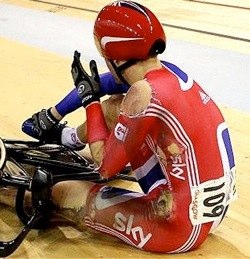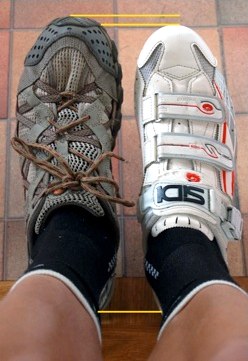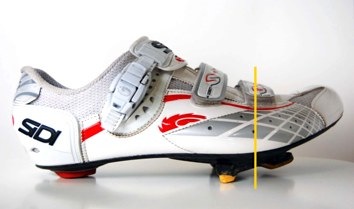So you bought a bike and the first piece of equipment to start riding: A helmet. Read "Fitting a lid" for tips on fitting your helmet correctly. Before going out in a fit of excitement and buying fancy shorts and a pro team jersey to match, I want to share an ugly story to help you prioritize your next step in kitting out for the road.

Source: Press Association
Cycling experience: (WARNING - Gory bit approaching). Some years ago while racing track, I crashed hard. I slid around the bank at top speed causing a couple of things to happen: First, the brand new and very expensive sponsor-provided skin suit completely shredded and ripped off, leaving me almost completely naked. Secondly, everything was bleeding. I remember looking down and thinking "Wow, that's a lot of road pizza" (next time you order a pizza, peel the cheese and toppings back; what you see looks exactly like your skin after sliding around the bank of a velodrome at high speed).
The positives from a crash like this is that my helmet worked well, protecting my head, my shoes stayed on, and my bike was still attached to my feet due to the double strap pedals. The two pieces of clothing that didn't fail, my helmet and shoes, fit perfectly and did their job.
These two pieces of equipment are vital to being a safe and effective rider. Sadly, all too often I see people out there rocking the latest team kit or beer jersey, their helmet sitting well back leaving forehead exposed, and on their feet; running shoes.
 The soles of running shoes, trainers, joggers or whatever you call them, are soft and squishy and bend around the pedal, mashing in and out like a pillow. This results in a waste of energy, plus the inevitable foot pain. Foot pain makes people stop riding. Helmet mal-fit can cause death.
The soles of running shoes, trainers, joggers or whatever you call them, are soft and squishy and bend around the pedal, mashing in and out like a pillow. This results in a waste of energy, plus the inevitable foot pain. Foot pain makes people stop riding. Helmet mal-fit can cause death.
Cycling shoes are not like running shoes. The soles are stiff so you can't feel the pedal press into your foot. They should also fit differently. Cycling shoes should not have the same thumb distance between your toe and the front of the shoe as you would with trainers. This thumb distance is to provide room so you don't remove your toe nails while pounding out the miles.
Cycling shoes need to be a more snug fit. You need to be connected to the bike so it feels like it's a part of you. Ideally, your toes should just feather the end of the shoe but not push against it. When pulling up on the pedal stroke while clipped in, your heel will not come out of the shoe. This is important if you want to win the sprint to the line!

Now you have a good fit it's time to look at cleats. Attach your cleats to the shoes then lace, clip or strap them closed like you are going for a ride. Find the middle of the ball of your foot (the widest part) and mark it with a line on a piece of tape stuck to the big toe side of your shoe. This mark should line up with your pedal spindle when clipped in.
Most cleats are built with float. This is a small amount of lateral movement which allows your foot to find its own natural alignment and angle. I set my cleats straight so my foot can find this natural alignment.
Cycling experience: I have an original set of clip in pedals I bought while racing in Holland in 1986. They have zero float. I also have several scars on my knees from knee operations. The float will help to avoid damage to your joints and subsequent scarring from a surgeon's knife.
One other thing to observe when positioning your cleat is the distance from your foot to the crank arm. Too close and the rubbing of shoe and ankle on the crank arm could potentially cause damage to both. Too far away and damage to your joints is a possibility.
Bike and cleat fit is a science of numbers, angles and also feeling. If you're not comfortable adjusting your cleats, many bike shops offer a professional bike fit service. This is a fantastic resource to rely on and learn from.
It never hurts to arrive at your local bike store (LBS) with a favourite snack of, "ahem", beverage. Share the love. Even though you're paying for the experience, some extra acknowledgement for the long suffering bike shop staff never goes wrong, and perhaps they'll take some extra time getting that shoe fit spot-on.


